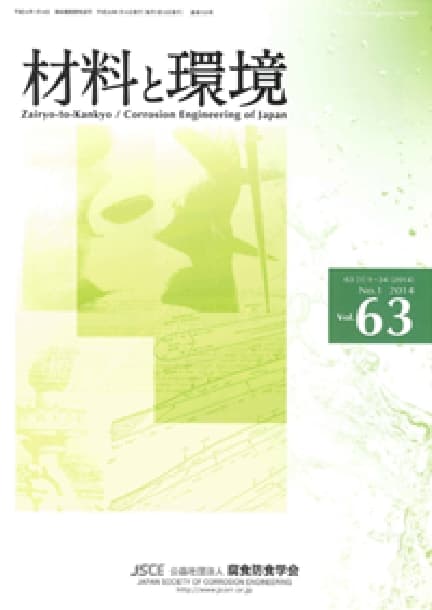- TOP
- Zairyo-to-Kankyo
- Vol. 69 (2020), No. 5
Zairyo-to-Kankyo Vol. 69 (2020), No. 5
Backnumber
-
Vol. 74 (2025)
-
Vol. 73 (2024)
-
Vol. 72 (2023)
-
Vol. 71 (2022)
-
Vol. 70 (2021)
-
Vol. 69 (2020)
-
Vol. 68 (2019)
-
Vol. 67 (2018)
-
Vol. 66 (2017)
-
Vol. 65 (2016)
-
Vol. 64 (2015)
-
Vol. 63 (2014)
-
Vol. 62 (2013)
-
Vol. 61 (2012)
-
Vol. 60 (2011)
-
Vol. 59 (2010)
-
Vol. 58 (2009)
-
Vol. 57 (2008)
-
Vol. 56 (2007)
-
Vol. 55 (2006)
-
Vol. 54 (2005)
-
Vol. 53 (2004)
-
Vol. 52 (2003)
-
Vol. 51 (2002)
-
Vol. 50 (2001)
-
Vol. 49 (2000)
-
Vol. 48 (1999)
-
Vol. 47 (1998)
-
Vol. 46 (1997)
-
Vol. 45 (1996)
-
Vol. 44 (1995)
-
Vol. 43 (1994)
-
Vol. 42 (1993)
-
Vol. 41 (1992)
-
Vol. 40 (1991)
Keyword Ranking
07 Dec. (Last 30 Days)
Zairyo-to-Kankyo Vol. 69 (2020), No. 5
Effect of Ligand Field on Cations Forming Complexes and the HSAB Principle
Kunitsugu Aramaki
pp. 137-139
DOI:
10.3323/jcorr.69.137Abstract
Effect of ligand field on cation forming complexes with precipitation inhibitors for metallic corrosion in aerated neutral solution are discussed based on the hard and soft acids and bases (HSAB) principle. The energy levels of three 3d orbitals, dxy, dxz and dyz in Fe3+, for example, decrease and two orbitals, dx2-y2 and dz2 increase markedly by approaching an effective ligand, :CN-, resulting in the formation of d2sp3 hybrid orbital. Contrary, less effective ligand like :NH3 provides sp3d2 hybrid orbital. Because chelating agents enhance the ligand field effect markedly, the d2sp3 hybrid orbital of Fe3+ can be provided for the formation of chelate compound, resulting in stable coordinate bonds between hard acid and hard base.
Initial Corrosion Behavior of Spheroidal Graphite Cast Iron in Atmospheric Environment
Ichiro Dote, Yuuki Kuwahara, Nobuhiro Kai, Shigenobu Kainuma
pp. 140-147
DOI:
10.3323/jcorr.69.140Abstract
This study focused on the differences in initial corrosion behavior of spheroidal graphite cast iron, carbon steel and weathering steel in atmospheric corrosive environment, the atmospheric exposure test and dry/wet cyclic test were conducted to examine the effect of graphite and Cu of spheroidal graphite cast iron on its initial corrosion behavior. After exposure to the atmosphere for two years, the mean corrosion depth of spheroidal graphite cast iron is smaller than that of carbon steel and similar to that of weathering steel, whereas the initial corrosion of spheroidal graphite cast iron progresses earlier than carbon steel and weathering steel, regardless of the temperature, humidity, and the amount of sea salt. From the initial corrosion test results in the wet-dry cyclic test, that Cu precipitation was observed at the corrosion origin of the spheroidal graphite cast iron, which is same as that in weathering steel. Based on the findings obtained in this study, a schematic diagram of the initial corrosion mechanism of spheroidal graphite cast iron was speculated.
Structure of Corrosion Product Formed on Carbon Steel Covered with NiSO4-added Resin Coating under Sulfuric Acid Mist Environment Containing Chloride
Shota Hayashida, Masamitsu Takahashi, Hiroshi Deguchi, Hiroaki Tsuchiya, Koushu Hanaki, Masato Yamashita, Shinji Fujimoto
pp. 148-153
DOI:
10.3323/jcorr.69.148Abstract
Corrosion resistance of carbon steel covered with resin coating containing nickel sulfate has been evaluated under chloride and sulfuric acid mist environment. The structure of corrosion products formed on steel surface was investigated by XRD and XAFS analyses using synchrotron radiation. Nickel sulfate promoted the formation of goethite and akaganeite. It was considered that this akaganeite was not tetragonal β-FeOOH but monoclinic akaganeite containing nickel.
Article Access Ranking
07 Dec. (Last 30 Days)
-
Perspectives on the Promising Pathways to Zero Carbon Emissions in the Steel Industry toward 2050
ISIJ International Vol.65(2025), No.2
-
Factors Influencing the Bonding Phase Structure of Iron Ore Sinters
ISIJ International Vol.43(2003), No.9
-
Effect of microstructural heterogeneity on fatigue limit of as-quenched low-carbon low-alloy martensitic steel
ISIJ International Advance Publication
-
Delayed Fracture Mechanism of 1700 MPa-Class Quenched and Tempered Bolt under Atmospheric Corrosion Environment
Tetsu-to-Hagané Advance Publication
-
Progress of Strip Casting Technology for Steel; Historical Developments
ISIJ International Vol.52(2012), No.12
-
Research Progress on Optimal Blending of Iron Ore Powders for Sintering
ISIJ International Vol.65(2025), No.12
-
-
Microstructures and Reduction Properties of High CaO Concentration Sintered Ore
ISIJ International Advance Publication
-
Influence of Antimony on the Oxidation Characteristics of 65Mn Steel
ISIJ International Advance Publication
-
Mechanism of Ammonium Thiocyanate Decomposition Driven by Electrolytic Hydrogen Charging
Zairyo-to-Kankyo Vol.74(2025), No.2
You can use this feature after you logged into the site.
Please click the button below.










